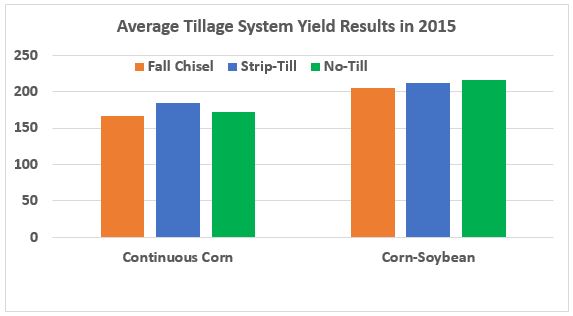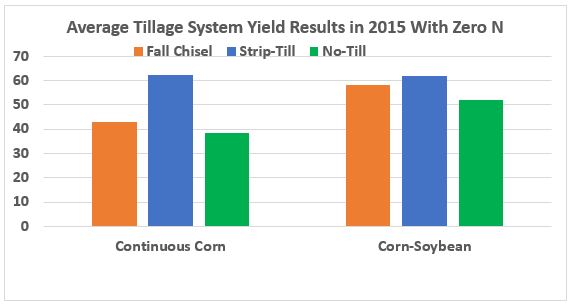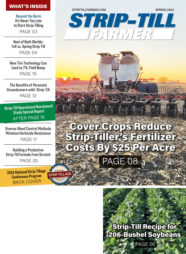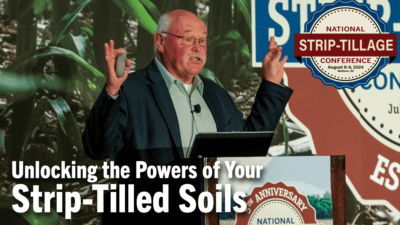Source: AGFAX
By Tony J. Vyn and Terry D. West, Purdue University
Given all the excessive rain and cool temperatures this spring in northern Indiana, there was some concern about how no-till and strip-till corn yields would end up at the end of the season.
Well, the results from the 41st year of our long-term tillage plots near West Lafayette, IN, are in and they tell an interesting story. These prairie soils (about 4% organic matter) at the site are silty clay loam and naturally poorly drained, but systematically tiled. We didn’t suffer from as much rain as some other counties, but we still had over 10″ of rain in June and over 7″ in July at this location.
The first surprise is that corn yields with no-till were better than chisel plowing in both continuous corn and in the corn-soybean rotation. Yields were 11 bushels per acre better than fall chisel plow and spring secondary tillage when corn followed soybean, and 5 bushels per acre better than the fall chisel plow in continuous corn (Figure 1). Most of the reason for that is the improved soil structure in long-term no-till versus chisel plow system (a system where we did secondary tillage with soil a little wetter than we wanted to simply so that we could accomplish planting by May 23).
Figure 1. Preliminary 2015 corn yield results from a long-term tillage experiment at West Lafayette, IN. Corn grain yields are averaged for with and without a nitrification inhibitor (Instinct®) when a 200 pound/acre side-dress N rate was applied as UAN at V4 stage.

Figure 1. Average Tillage System Yield Results in 2015 – Note: All tillage treatments were planted with the same hybrid (P1498 CHR) on the same day (May 23, 2015). Starter N was applied as 10-34-0 (20 gallons/acre) and sidedress N was applied as coulter-banded UAN to give a total N application of 223 pounds N/acre for all plots. Plant populations averaged 33,600 and were not affected by tillage or rotation treatments.
Normally, no-till corn yields about equal to the fall chisel plow system when corn follows soybean, but not when corn follows corn. In fact, no-till corn after corn is usually about 7% lower in yield than the fall chisel system even when we do everything right in terms of best management for no-till.
The second surprise is that corn yields with strip-till were better than both chisel plow and no-till when corn followed corn, and about equal to no-till when corn followed soybean (Figure 1). Usually strip-till corn yields equal those with the fall disk-chisel system, but this year they surpassed the chisel system by 18.5 bu/acre when corn followed corn. The main advantage of seeding into a friable, dry and warmer strip of soil with minimal soil compaction during planting is the key advantage here for the fall strip-till system.
Yields with the strip-till system may have been even higher if we had taken advantage of the earlier soil drying to plant even earlier. But, in this research, all tillage systems were planted on the same day. The spring of 2015 was so wet and cool that the fall strip-till system offered a great opportunity for an extended number of planting days between the frequent rain events.
The third surprise is that strip-till resulted in higher yields than chisel plowing even when no nitrogen (N) was applied except for the 23 pounds of N in the starter band at planting (Figure 2). The relative yield gain for strip-till when no side-dress N was applied was especially apparent in continuous corn. The results of this table also make it abundantly clear that even 40 years of continuous no-till do not magically result in more available mineral N in soil for corn to use. It is doubtful that farmers can be successful in no-till corn production systems by using lower N rates than they do in conventional tillage systems, and certainly not when corn follows corn or a grass or cereal cover crop.
Figure 2. Preliminary 2015 corn yield results from a long-term tillage experiment at West Lafayette, IN. Corn grain yields are averaged for the first time corn had ever been produced on these plots with anything less than 180-240 pounds of N/acre since 1975.

Figure 2. Average Tillage System Yield Results in 2015 With Zero N – Note: All tillage treatments were planted on the same day (May 23, 2015). Starter N was applied as 10-34-0 (20 gallons/ac) and zero sidedress N was applied.
Frustrated farmers are understandably strongly tempted to do deep and intensive tillage following a disappointing corn harvest in 2015. But these results, and others like them over the decades in the Eastern Cornbelt provide reassurance that both no-till and strip-till can maintain or increase corn yields compared to the most common fall tillage system.
Extreme rain events (such as getting 5 or more inches in 24 hours) also make soil protection with residue cover even more important. Strip-tillage, done properly, is an even more reliable tillage system than some conventional tillage alternatives in both continuous corn and corn-soybean rotations.
Finally, these yield results confirm once again that the benefits of rotating corn with soybean instead of growing corn after corn are particularly obvious when weather conditions during the growing season (and especially the early part of the growing season) are unfavorable.
Corn yields averaged 17% lower when corn was grown continuously in 2015; that compares to a 10% yield reduction for continuous corn versus corn after soybean with the same 3 tillage systems in the last 5 years (2010-2014). So the bottom line is that crop rotation pays, and adoption of either strip-till or no-till pays dividends despite severe weather challenges.






Post a comment
Report Abusive Comment